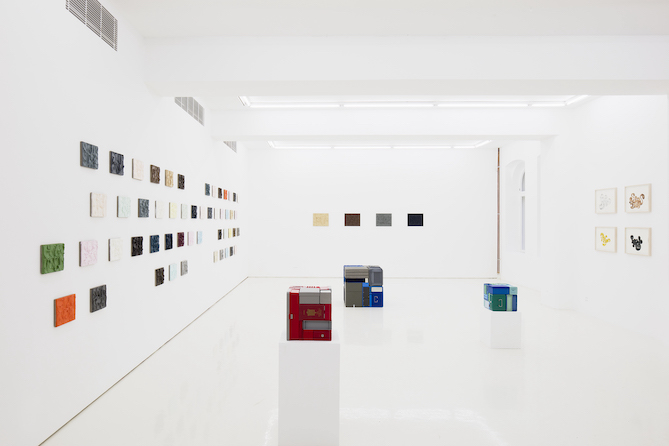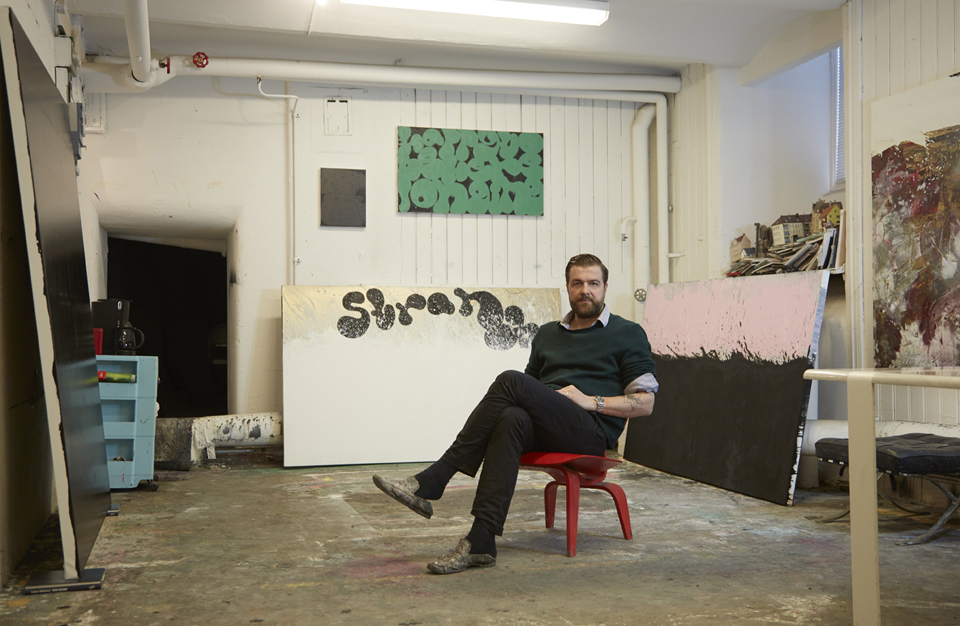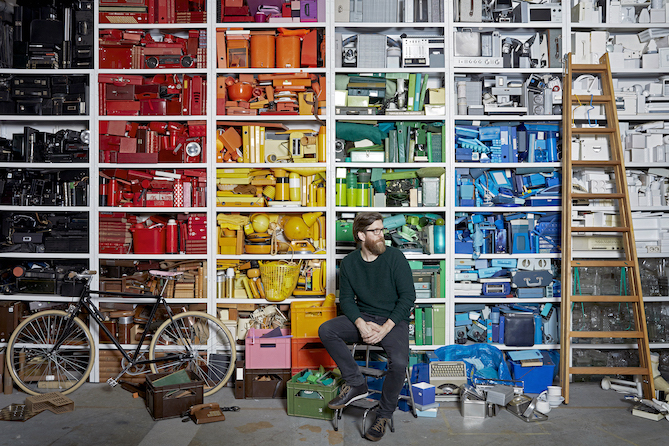
View in 360:
Use the arrows or click and drag to navigate in the 360 tour, click on an artwork for more information. Please do not hesitate to contact the gallery staff with any questions. Open in new window for better viewing >>>
Repetitions is a joint exhibition of two prominent Swedish artists, Lukas Göthman and Michael Johansson. The artists work with different media – painting and sculptural installation – but both approach their subjects through the act of repetition. The works in the exhibition are in dialogue with each other, they occupy both the walls and the floor of the gallery space and carry a certain conceptual quality, a negotiation between form and thought.
Although Lukas Göthman works with oil paintings, his use of material approaches sculpture in its three-dimensionality. The artist works with words that have a semantic meaning, but most of all possess and transmit a certain feeling. The starting point for the works in the exhibition is in the artist’s diaries, recollections of voyages and travels. The fleeting moments and memories, both real and imaginary, are translated into clear colours, full of life and sentiment, at times vivid and happy, at times melancholic, soft and misty. Impressions of things that could or should have been, “life in a curated mode”.
Repetition is evident and manifested in a particular wall in the gallery space, holding over 40 of Göthman’s small paintings. The series of works, Paintnotes, was first born out of the idea of not wasting leftover paint but rather creating something entirely new out of it. In the series, Göthman uses paint lavishly. The words in the paintings become abstract in the sensual, tactical thickness of the material.
Just as Göthman works with leftover paint, the idea of recycling, reusing or rediscovering is very much present in Michael Johansson’s works, where everyday objects are given a new life and meaning, to a point where their original use is completely forgotten or becomes solely an addition to the layers of meanings in the works. The interplay of shapes, colours and patterns in the artist’s sculptures and installations create a logic of their own, playful and imaginative. Through the reimaginations, the works, familiar yet strange at the same time, become unnerving, uncanny.
Johansson is interested in the possibilities and limits of space. He searches for various objects and situations as the basis for his works, and creates new, smaller, puzzle-like entities inside their pre-existing patterns and empty spaces. The sculptures in Repetitions also function as mirror images of themselves, like visual palindromes: the same logic is repeated over and over, no matter where you look at them from.
The dialogue and tension between the works in the exhibition is also born in repetition. Johansson has used the colours from Göthman’s paintings as a starting point for the colour schemes of his own works. The act of repetition is a way of moving forward – as the familiar becomes something strange and new, instead of closing or ending up in a dead end, repetition starts to open up new horizons and create new ways of seeing and conversing. Through it, a feeling of temporality is born, of moments passing by.
Lukas Göthman (b. 1970) lives and works in Stockholm. Göthman is a self-taught artist. He has exhibited widely in his homeland of Sweden since the early 2000s, and also appeared in exhibitions in various parts of Europe, e.g. in Stockholm, Malmö, Amsterdam and Paris, as well as in Japan, for example. Göthman has also worked with performances and site-specific projects.
Michael Johansson (b.1975) lives and works in Berlin. He graduated from Malmö Art Academy in 2005, and has since exhibited widely in galleries and museums internationally, eg. in Haag, Milan, Tokyo and Mexico City. Johansson's works are included in many central international public collections. He has created numerous commissioned works for public spaces and buildings in the Nordics and, in 2020 for the first time, in Finland, at Tuusula's Rykmentinpuisto
Repetitions on kahden merkittävän ruotsalaistaiteilijan, Lukas Göthmanin ja Michael Johanssonin yhteisnäyttely. Eri välinein, maalauksen ja veistoksellisen installaation parissa työskentelevät taiteilijat lähestyvät kumpikin aiheitaan toiston kautta. Näyttelyn teokset ovat vuoropuhelussa keskenään ja levittäytyvät sekä gallerian seinille että lattialle. Ne sisältävät tiettyä konseptuaalisuutta, neuvottelua muodon ja ajatuksen välillä.
Vaikka Lukas Göthman työskentelee öljymaalauksen parissa, hänen materiaalinkäyttönsä lähestyy veistoksellisuutta kolmiulotteisuudessaan. Taiteilija työskentelyn keskiössä ovat sanat, joilla on kielellinen merkitys, mutta jotka ennen kaikkea sisältävät ja välittävät tunteita. Näyttelyn teosten lähtökohdat ovat taiteilijan päiväkirjoissa, muistoissa matkoista ja maisemista. Hetket ja muistot – eletyt ja kuvitteelliset – piirtyvät selkeisiin väreihin, jotka ovat täynnä elämää ja tunnetta, toisinaan kirkkaita ja eloisia, toisinaan utuisia ja pehmeitä. Häivähdyksiä jostain, joka olisi voinut olla tai jonka olisi pitänyt olla: ”elämää kuratoituna.”
Toisto toteutuu selkeänä yhdessä galleriatilan seinässä, johon on ripustettu yli 40 Göthmanin pientä maalausta. Teossarja nimeltään Paintnotes sai alkunsa ajatuksesta olla tuhlaamatta ylijäänyttä maalia, vaan sen sijaan luoda siitä jotain ihan uutta. Göthman käyttää sarjan teoksissa maalia kitsastelematta. Sanat muuntuvat abstrakteiksi materiaalin sensuellissa, käsin kosketeltavassa runsaudessa.
Siinä missä Göthman työskentelee ylijäänein maalein, ajatus uudelleenkäyttämisestä ja kierrätyksestä, uudelleen keksimisestä on voimakkaasti läsnä myös Michael Johanssonin teoksissa, joissa jokapäiväiset esineet saavat uuden elämän ja merkityksen, jopa niin, että esineen alkuperäinen tarkoitus katoaa tai muuttuu vain osaseksi teoksen sisältämiä tulkinnan mahdollisuuksia. Muotojen, värien ja kuvioiden yhteispeli muodostaa oman leikkisän ja mielikuvituksellisen logiikkansa. Uudelleenkuvittelun myötä teokset, yhtä aikaa tutut ja vieraat, muuttuvat omituisiksi, kummiksi.
Johansson on kiinnostunut tilan mahdollisuuksista ja rajoituksista. Hän etsii eri esineitä ja tilanteita teostensa lähtökohdiksi ja luo uusia, pienempiä, palapelinomaisia kokonaisuuksia niiden sisälle, olemassa oleviin muotoihin ja tyhjiksi jääviin tiloihin. Repetitions-näyttelyn veistokset toimivat myös peilikuvina itselleen, kuin visuaalisina palindromeina: sama logiikka toistuu yhä uudelleen, mistä hyvänsä kulmasta teoksia katsoo.
Näyttelyn teosten keskinäinen dialogi ja jännite syntyy myöskin toistossa. Johansson on käyttänyt omien veistostensa värimaailmojen lähtökohtina Göthmanin maalauksia. Toisto tekona on tapa liikkua eteenpäin – kun tutusta tulee jotakin omituista ja uutta, alkaa toisto aukaista uusia horisontteja ja katsomisen tapoja umpikujien sijaan. Sen myötä syntyy tunne ajallisuudesta, ohitse kiitävistä hetkistä.
Lukas Göthman (s. 1970) asuu ja työskentelee Tukholmassa. Göthman on itseoppinut taiteilija, jonka teoksia on ollut esillä yksityis- ja ryhmänäyttelyissä eri puolilla Ruotsia ja Eurooppaa, mm. Tukholmassa, Malmössa, Amsterdamissa ja Pariisissa sekä esimerkiksi Japanissa. Göthmanin teoksia on viimeksi nähty yksityisnäyttelyssä Tukholman Björkholmen Galleryssa.
Michael Johansson (s. 1975) asuu ja työskentelee Berliinissä. Johansson valmistui Malmön kuvataideakatemiasta vuonna 2005 ja on esiintynyt kansainvälisissä museo- ja gallerianäyttelyissä mm. Haagissa, Milanossa, Tokiossa, Mexico Cityssä Meksikossa ja Le Havressa Ranskassa. Taiteilijan teoksia sisältyy lukuisiin kansainvälisiin julkisiin kokoelmiin. Hän on lisäksi toteuttanut useita tilausteoksia julkisiin tiloihin ja rakennuksiin Pohjoismaissa, vuonna 2020 ensi kertaa myös Suomessa, Tuusulan Rykmentinpuistossa.
Separatutställningen Repetitions presenterar två betydande svenska konstnärer, Lukas Göthman och Michael Johansson. De arbetar med måleri och skulptural installation med varierande teknik, och båda närmar sig sina motiv via repetition. Utställningens verk för en dialog med varandra och breder ut sig över galleriets väggar och golv. Där ingår konceptuella element, överläggning mellan form och tanke.
Lukas Göthman arbetar med oljemåleri, som via hans tredimensionella materialhantering dock tangerar det skulpturala. I fokus för Göthmans konst står ord som har en språklig betydelse men som framför allt bär på och förmedlar känslor. De utställda verken utgår från konstnärens dagböcker, reseminnen och landskap. Ögonblick och minnen – självupplevda lika väl som fiktiva – får sin skepnad i klara färger fulla av liv och känsla, ibland bjärta och livfulla, ibland dämpade och mjuka. Glimtar av någonting som kunde eller borde ha varit: ”kuraterat liv”.
Det repetitiva framträder tydligt på en av väggarna där det hänger över 40 små målningar av Göthman. Denna verkserie med titeln Paintnotes fick sin början från tanken att inte slösa med överbliven målarfärg utan i stället använda den till någonting nytt. Göthman snålar inte med färgen i sin verkserie. Orden antar en abstrakt skepnad i materialets sensuella, handgripliga ymnighet.
Där Göthman arbetar med överbliven målarfärg är idén om återanvändning, återvinning och återuppfinning starkt närvarande också i Michael Johanssons verk. I dem får alldagliga föremål nytt liv och en ny betydelse, rentav så att föremålets ursprungliga syfte förflyktigas eller reduceras till blott en liten del av verkets talrika tolkningsmöjligheter. Formernas, färgernas och figurernas samspel skapar en egen logik, lika lekfull som fantasieggande. I och med alla nya tolkningsmöjligheter framstår verken med sina både välbekanta som främmande föremål som förunderliga, mystiska.
Johansson fascineras av rummets potential och begränsningar. Han letar efter föremål och situationer som utgångspunkt för sina verk och skapar nya, mindre och pussellika världar inuti dem, i de redan existerande formerna och de tömda rummen. Skulpturerna på utställningen fungerar också som sina egna spegelbilder, som visuella palindromer: samma logik upprepas om och om igen, oavsett från vilken vinkel vi betraktar verket.
Dialogen och spänningen mellan de utställda verken uppstår också i repetitionen. Johansson har använt Göthmans målningar som utgångspunkt för skulpturernas färgsättning. Repetition är ett sätt att röra sig framåt: då det välbekanta blir egendomligt och nytt öppnar repetitionen nya horisonter och synsätt, inte återvändsgränder. Då uppstår också tidskänslan, känslan av förbiilande ögonblick.
Lukas Göthman (f. 1970) bor och är verksam i Stockholm. Han är en självlärd konstnär vars verk visats på separat- och grupputställningar runtom i Sverige och på kontinenten, bl.a. i Stockholm, Malmö, Amsterdam och Paris samt även i Japan. Senast har Göthmans verk visats på en separatutställning på Björkholmen Gallery i Stockholm.
Michael Johansson (f. 1975) bor och är verksam i Berlin. Han har en MFA från Konsthögskolan i Malmö 2005 och har ställt ut på musei- och galleriutställningar runtom i världen, bl.a. i Haag, Milano, Tokio, Mexico City och Le Havre. Hans verk ingår i många internationella offentliga samlingar. Johansson har också gjort flera beställningsverk till offentliga rum och byggnader i Norden, i år för första gången även i Finland, i Regementsparken i Tusby.


Share this exhibition